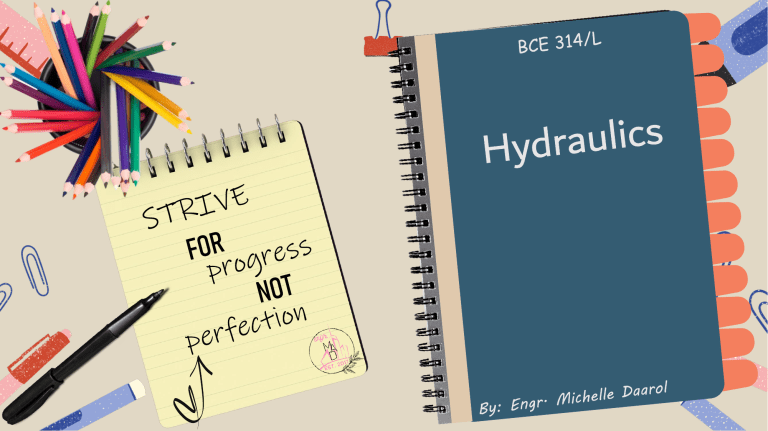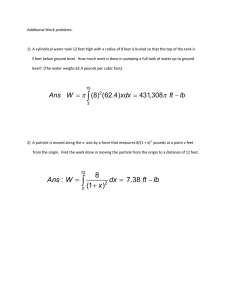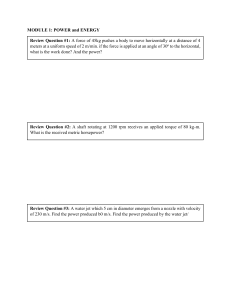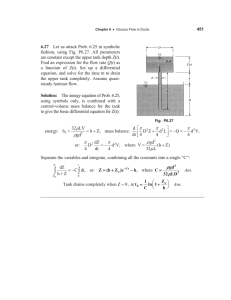
Relative Equilibrium of Fluids Rectilinear Motion (Moving Vessel) • Horizontal Motion 𝜃 at rest vehicle/truck moving vehicle • the fluid is disheveled inside • the rear side is experiencing max Fh (hydrostatic force) Relative Equilibrium of Fluids Rectilinear Motion (Moving Vessel) • W Thus: REF 𝜃 𝜃 N 𝜃 𝑡𝑎𝑛𝜃 = 𝑅𝐸𝐹 𝑀𝑎 = 𝑊 𝑀𝑔 𝑎 𝑡𝑎𝑛𝜃 = 𝑔 REF W Relative Equilibrium of Fluids Rectilinear Motion (Moving Vessel) Inclined Motion • 𝑎𝐻 𝑡𝑎𝑛𝜃 = 𝑔 ± 𝑎𝑣 • • • Vertical Motion 𝑃𝐵𝑂𝑇𝑇𝑂𝑀 𝑎 = 𝛾ℎ 1 ± 𝑔 Use (+) upward motion Use (- )downward motion Relative Equilibrium of Fluids Rotating Vessels Volume of paraboloid air liquid Relative Equilibrium of Fluids Rotating Vessels 𝜔2 𝑥 𝑡𝑎𝑛𝜃 = 𝑔 𝝎 𝑡𝑎𝑛𝜃 is the slope of the paraboloid at (x,y) 𝜔2 𝑥 2 𝑦= 2𝑔 𝜔 = angular speed in radians/s 𝑟𝑒𝑣 1 𝑚𝑖𝑛 = 𝜋 30 rad/s Relative Equilibrium of Fluids 𝝎 Rotating Vessels 𝒙 𝑃𝑎𝑟𝑎𝑏𝑜𝑙𝑜𝑖𝑑: 𝑦 𝒙𝟏 𝒚𝟏 𝑥12 𝑥2 = 𝑦1 ` 𝑦` 𝑦 = ℎ𝑒𝑖𝑔ℎ𝑡 𝑜𝑓 𝑝𝑎𝑟𝑎𝑏𝑜𝑙𝑜𝑖𝑑 1 2 𝑉𝑜𝑙𝑢𝑚𝑒 = 𝜋𝑟 𝑦 2 𝒚 𝝎 If 𝟐 < 𝑫 𝑦 open 𝜔2 𝑥 2 𝑦= 2𝑔 𝒚 𝟐 If = 𝑫 𝐷 𝝎 air 𝑥 𝑦 If > 𝑫 air 𝝎 𝑥 4 If 𝒚 = 𝑯 𝑦 NO SPILL 1 air 𝑥 5 𝝎 If y > 𝑯 𝝎 𝑥 IN THE VERGE OF SPILLING 2 air SOME SPILLED, VORTEX NOT TOUCHES YET THE BOTTOM 3 STAGES OF PARABOLOID AT INCREASING ANGULAR VELOCITY, 𝝎 (rad/s) 𝐻 LIQUID 𝒚 𝟐 𝑦 air 𝑦 SOME SPILLED, VORTEX NOW TOUCHES THE BOTTOM CENTER SOME SPILLED, VORTEX BEYOND THE BOTTOM Examples An open rectangular tank mounted on a truck is 5 m long, 2 m wide and 2.5 m high is filled with water to a depth of 2 m. a. What is the maximum horizontal acceleration can be imposed on the tank without spilling any water b. Determine the accelerating force on the liquid mass. c. If the acceleration is increased to 6 m/s^2, how much water is spilled out? Ans: a=1.962 m/s^2; F = 39.24 kN; Vspilled = 9.78 cu.m Examples A closed horizontal cylindrical tank 1.5 m in diameter and 4 m long is completely filled with gasoline (s.g. = 0.82) and accelerated horizontally at 3 m/s^2. a. Find the total force acting on the rear wall of the tank. b. Find also the accelerating force on the fluid mass. Ans: Frear = 28.05 kN; Fnet = 17.36 kN Examples A closed rectangular tank 4 m long, 2 m wide, and 2 m high is filled with water to a depth of 1.8 m. If the allowable force at the rear wall of the tank is 200 kN, how fast can it be accelerated horizontally? Ans: 13.72 m/s^2 Examples A vessel 3 m in diameter containing 2.4 m of water is being raised. a. Find the pressure at the bottom of the vessel in kPa when the velocity is constant. b. Find the pressure at the bottom of the vessel when it is accelerating 0.6 m/s^2 upwards. Ans: 23.54 kPa; 24.98 kPa Examples A vessel containing oil is accelerated on a plane inclined 15 degrees with the horizontal at 1.2 m/s^2. Determine the inclination of the oil surface when the motion is: a. Upwards b. Downwards Ans: 6.53 degrees; 6.96 degrees Examples Rotating Vessels An open cylindrical vessel having a height equal to its diameter is half-filled with water and revolved about its own vertical axis with a constant angular speed of 120 rpm. Find its minimum diameter so there can no liquid spilled. Ans: 497 mm Examples Rotating Vessels An open cylindrical tank 1.6 m in diameter and 2 m high is full of water. When rotated about its vertical axis at 30 rpm, what would the slope of the water surface at the rim of the tank? Ans: 0.81 Examples Rotating Vessels An open cylindrical tank 1.2 m in diameter and 2.1 m high is 2/3 full of water. Compute the amount of water in liters that will be spilled out if the vessel is rotated about its vertical axis at a constant angular speed of 90 rpm. Ans: 130 L Examples Rotating Vessels An open cylindrical tank, 2 m in diameter and 4 m high contains water to a depth of 3 m. It is rotated about its own vertical axis with a constant angular speed 𝜔. a. If 𝜔 = 3 rad/sec, is there any liquid spilled? b. What maximum value of 𝜔 (in rpm) can be imposed without spilling any liquid? c. If 𝜔 = 8 rad/sec, how much water is spilled out? d. What angular speed 𝜔 (in rpm) will just zero the depth of water at the center of the tank? e. If 𝜔 = 100 rpm, how much area at the bottom will be uncovered? Ans: no spill; 59.8 rpm; 1.98 cu.m; 84.6 rpm; 0.889 sq.m Examples Rotating Vessels A closed cylindrical vessel, 2 m in diameter and 4 m high is filled with water to a depth of 3 m and rotated about its own vertical axis at a constant angular speed 𝜔. The air inside the vessel is under a pressure of 120 kPa. a. If 𝜔 = 12 rad/sec, what is the pressure at the center and the circumference at the bottom of the tank? b. What angular speed 𝜔 will just zero the depth of water at the center? c. If 𝜔 = 20 rad/sec, how much area of the bottom is uncovered? Ans: 121.66 kPa and 193.64 kPa; 119.6 rpm; 0.48 sq.m Examples Rotating Vessels A closed cylindrical vessel, 1.5 m in diameter and 3.6 m high is ¾ full of brine (s=1.3) and is revolved about its own vertical axis with a constant angular speed. The vessel is made up of steel 9 mm thick with an allowable tensile stress of 85 MPa and has a small opening at the center of the top cover. a. If the angular speed is 210 rpm, what is the maximum stress in the walls? b. To what maximum angular speed can the vessel be revolved? Ans: 12.96 MPa; 576 rpm





